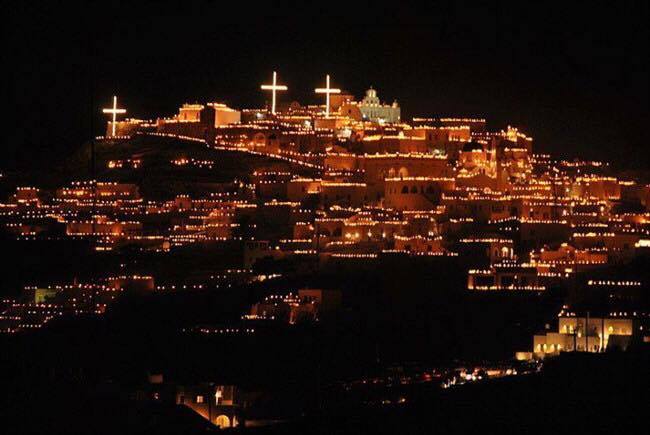
One of the greatest celebrations of Christianity is Easter. If Christmas is a commercial celebration, Easter is the most sacred observance in the Greek Orthodox faith and is the most important holy celebration in Greece, even more important than Christmas.
One of the greatest celebrations of Christianity is Easter. If Christmas is a commercial celebration, Easter is the most sacred observance in the Greek Orthodox faith and is the most important holy celebration in Greece, even more important than Christmas. What characterizes this time of the year is that all Greeks gather with their families and spend these holy days all together, most of the times, at the countryside. After all, Easter is the culmination of a long spiritual preparation that takes place for 40 days during the Lent when most of the faithful people traditionally keep strict fasting. In this they give themselves body and soul into the culmination of the Passion of Christ and finally rejoicing in His Resurrection.
Preparations for Easter come to a climax toward the end of Holy Week, between Palm Sunday and Easter. But on Santorini it starts a day before: it all begins at Lazarus Saturday. The ultimate place to be at that day is the cute and picturesque village of Megalochori where the whole village build the “Lazarus”. What is “Lazarus? “ Lazarus is a big wooden cross covered with rosemary and flowers made in the morning of Lazarus Saturday by the unmarried boys and girls of the village. Lazarus will be kept ornated at the traditional square of the village till the day before Easter Sunday.
As everywhere in Greece, in Santorini as well, on Holy Thursday the housewives bake the traditional Easter bread, tsoureki, and dye the eggs red cause red is the color of life as well as a representation of the blood of Christ that symbolises the renewal of life. At Holy Saturday midnight, soon after the priest says Christos Anesti (Christ is Risen) and bells start ringing the game of (hard boiled) egg cracking— or “tsougrisma” begins! Two people compete by holding their respective egg in their hand and tapping at each other’s egg. The goal is to crack the other player’s egg. The winner, then, uses the same end of the egg to tap the other, non cracked end of the opponent’s egg. The champion is the one, whose egg will crack the eggs of all the other players. Back to Holy Thursday, the housewives of Santorini prepare traditional melitinia, (is hard to be explained so take a look at the photo)

THE local recipe that characterizes Easter at Santorini. The preparation of this tiny, cute sweet is veeeeery long and demanding! You have to be a really skillful and experienced cook to make the right, proper, good melitini. First of all, when we make Melitinia, we make two things: the dough and the staffing but the most demanding part is the “pinching” . The more pinches the better! Until recently housewives used to show off what good housewives they were by the number of the pinches on the melitinia. And unofficial contests used to take place among them 🙂
And after all preparations we are ready for the holiest day of Holy Week: Holy Friday. It is a day of mourning, neither of work nor of eating, with the most devoted fasting persons not even drinking water. Church bells keep ringing all day long in a sad way. Early in the evening of Holy Friday Emporio is the place to be where the folklore custom of simantra takes place. But just after sunset you HAVE to be at Pyrgos village area!
On Good Friday’s night, after the deposition from the Cross begins the funeral procession of Jesus Christ. At the alleys of Pyrgos village one of the most impressive processions takes place. Hundreds of aluminum cans, stuffed with flammable materials, placed on the roofs and the walls of the Venetian castle by young boys, are lightened up, creating an evocative and thrilling picture and a unique atmosphere. Whether you are standing in the middle of the village or just looking from a nearby spot, the spectacle of Good Friday in Pyrgos is a one of kind celebration. The view from a distance is breathtaking since the whole village seems to be on fire but being in the labyrith- like alleys of Pyrgos is an unforgettable experience (even though it is always crowded). NOT to be missed, it is just spectacular.
On Great Saturday night at midnight everybody is at church celebrating The Rise of Christ. The Priest passes the Holy Flame and everybody sings “Christos Anesti” (Christ is Rise). Most of the times the fireworks make the night day.
On Easter Sunday you will smell the lamps roasting over a fire pit for several hours, before being taken home for the family feast. Every area of the country has their own way of doing things. The roasting starts early in the morning and by midday all the big, Greek family gathers around the table which is usually set outside the house, in the yard. With traditional Greek music at the background, Greeks feast, crack the red eggs, and celebrate all together!
Summing up, Santorini during spring time is amazing and without any doubt, no matter if religious or not, you will find a lot of pleasure in exploring Easter traditions in this magnificent place.
Lots of love,
Eugenia,
Your Santorini guide 😉





